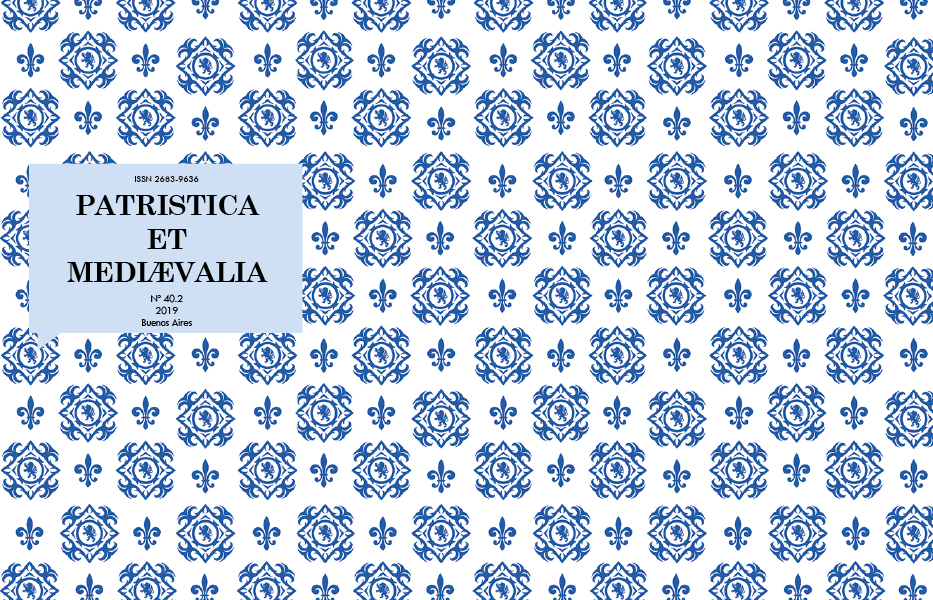The Partial Eclipse of Plotinus in the Middle Ages and his Recovery in the Renaissance
Abstract
This article studies the Plotinian presence in the Middle Ages and the Renaissance. First, it accounts for the indirect transmission of the Enneads throughout Medieval times and the editions that reappears in the Renaissance. In this regard, it discusses the presence and influence of Plotinian ideas on Medieval thinkers. Secondly, it examines some main points of Plotin’s thought –the three hypostases and a single universe– and thirdly, presents the profound coincidences between Plotin and Nicholas of Cusa’s ideas, analyzing the pairings enfolding-unfolding, uncontracted-contracted. Finally, it considers the possibility of reuniting both lines in a Grand Unified Theory that goes through all the Middle Ages.Downloads
References
Adamson, P. (2016). A history of Philosophy without any Gaps: Philosophy in the Islamic World. Oxford: Oxford University Press.
Adamson, P. (2017). The Arabic Plotinus: A Philosophical Study of the ‘Theology of Aristotle’ (Gorgias Islamic Studies). Nueva Jersey: Gorgias Press.
Armstrong, A. H. (1967). “Plotinus”. En: Idem (ed.). The Cambridge History of Later Greek and Early Medieval Philosophy. Cambridge: Cambridge University Press, 195-270.
Bouillet, M.-N. (1857). “Préface”. En: Plotin. Les Ennéades de Plotin. Trad. Idem. París: Hachette.
Bussanich, J. (1988). The One and its Relations to Intellect in Plotinus: A Commentary on Selected Texts. Leiden: Brill.(Philosophia Antiqua 49).
Bussanich, J. (2007). “Plotinus on the Being of the One”. En: Finamore, J. & Berchman, R. (eds.). Metaphysical Patterns in Platonism. Nueva Orleans: University Press of the South, 57-72.
Corrigan, K. (2008). “Ousia and Hypostasis in the Trinitarian Theology of the Cappadocian Fathers: Basil and Gregory of Nyssa”, Zeitschrift für Annikes Christentum12, 114-134.
Corrigan, K. (2002). Reading Plotinus: A Practical Introduction to Neoplatonism. Indiana: Purdue University Press.
Dillon, J. (1973). Iamblichi Chalcidensis in Platonis dialogos commentariorum fragmenta. Leiden: Brill. (Philosophia Antiqua 23).
Dodds, E. R. (1936). Journal and Letters of Stepehen MacKenna. Edited with a Memoir by E. R. Dodds. Londres: Constable and Co Ltd.
D’Ancona, C. (2010). “The Origins of Arabic Philosophy”. En: Gerson, L. (ed.). The Cambridge History of Philosophy in Late Antiquity (v. II). Cambridge: Cambridge University Press, 869-893.
Goulet-Cazé, M.-O. (1982). “L’édition porphyrienne des Ennéades. État de la question”. En: Brisson, L., Goulet-Cazé, M.-O., Goulet, R. & O’Brien, D. (eds.). Porphyre. La Vie de Plotin. Travaux préliminaires et index grec complet (v. I). París: Vrin, 229-327.
Henry, P. (1935). Recherches sur la Préparation Évangélique d’Eusèbe et l’édition perdue des œuvres de Plotin publiée par Eustochius. París: Leroux (Bibliothèque de l’École des Hautes Études. Sciences religieuses 50).
Henry, P. (1937). “Vers la reconstruction de l’enseignement oral de Plotin”, Bulletin de l’Académie Royale de Belgique, Classe des Lettres 23, 310-342.
Henry, P. (1938). Études plotiniennes I. Les états du texte de Plotin. Bruselas: L’Édition Universelle.
Henry, P. (1948). Études plotiniennes II. Les manuscrits des Ennéades. Bruselas: L’Édition Universelle.
Hopkins, J. (1983). Nicholas of Cusa’s. Metaphysics of Contraction. Mineápolis: The Arthur J. Banning Press.
Karamanolis, G. (2006). Plato and Aristotle in Agreement? Platonics on Aristotle from Antiochus to Porphyry. Oxford: Oxford Scholarship Online.
Koyre, A. (1957). From the Closed World to the Infinite Universe. Baltimore: The Johns Hopkins Press.
Laurens, P. (2012). “Introduction”. En: Marsile Ficin. Commentaire sur le Banquet de Platon. De l’amour/ Commentarium in Convivium Platonis. De amore.
Lloyd, A. C. (1967). “The Later Neoplatonists”. En: Armstrong, A. H. (ed.). The Cambridge History of Later Greek and Early Medieval Philosophy. Cambridge: Cambridge University Press, 272-329.
Narbonne, J. M., Achard, M. y Ferroni, L. (ed. y trad.) (2012). Plotin. Œuvres com-plètes. Introduction, Traité 1 (I 6): Sur le Beau. París: Les Belles Lettres.
Natorp, P. (2004). Plato’s Theory of Ideas. An Introduction to Idealism. Baden: Academia Verlag.
O’Meara, D. (1992). Plotinus: An Introduction to the Enneads. Oxford: Clarendon Press. Medieval Neoplatonism. Cambridge: Cambridge University Press.
Saffrey, H. (1996). “Florence, 1492: The Reappearance of Plotinus”, Rennaisance Quaterly 49, 488-508.
Sleeman, J. H. yPollet, G. (1980). Lexicon Plotinianum. Leiden: Brill.
Schwyzer, H.-R. (1941). “Die pseudoaristotelische Theologie und die Plotin-Ausgabe des Porphyrios”, Museum Helveticum 90, 216-236.
Schwyzer, H.-R. (1951). “Plotinos”, Paulys Realenzyklopädie der klassischen Alter-tumswissenschaft 21, 471-592 [Con notas suplementarias en 1978, Paulys Real-enzyklopädie, Suppl. 15, 321-323] Munich: Metzler.
Thillet, P. (1971). “Indices porphyriens dans la théologie d’Aristote”. En: Hadot, P. y Schuhl, P.-M. (eds.). Le Néoplatonisme. París: CNRS, 293-302.
Turner, J. D. (2001). Sethian Gnosticism and the Platonic Tradition. Quebec: Les Presses de l’Université Laval; Lovaina - París: Peeters. (Bibliothèque Copte de Nag Hammadi, Études 6).
Versluis, A. (2017). Platonic Mysticism: Contemplative Science, Philosophy, Literature, and Art. Albany - Nueva York: SUNY Press.
Zimmerman, F. W. (1986). “The Origins of the So-Called Theology of Aristotle”. En: Kraye, J., Ryan, W. F. y Schmidt, C.-B. (eds.). Pseudo-Aristotle in the Middle Ages: The ‘Theology’ and Other Texts. Londres: Warburg Institute, 110-240. (WI Surveys and TextsXI).
Pessin, S. (2013). Ibn Gabirol’s Theology of Desire: Matter and Method in Jewish.
1. The authors who publish in this magazine accept the following conditions:
-
They retain the copyright and grant to the magazine the right of the first publication, with the work registered under the Attribution-ShareAlike 4.0 International License that allows third parties to use what is published as long as they mention the authorship of the work and the first publication in this magazine.
-
They can make other independent and additional contractual agreements for the non-exclusive distribution of the version of the article published in this magazine (eg. include it in an institutional repository or publish it in a book) provided that they clearly indicate that the work was first published in this journal.
-
They are allowed and recommended to publish their work on the Internet (for example on institutional or personal pages).
2. AutoArchive Conditions. Authors are allowed and encouraged to distribute post-print electronic versions of their manuscripts because it promotes their circulation, a possible increase of quotation and a major reach among the Academic community. Color RoMEO: blue.













